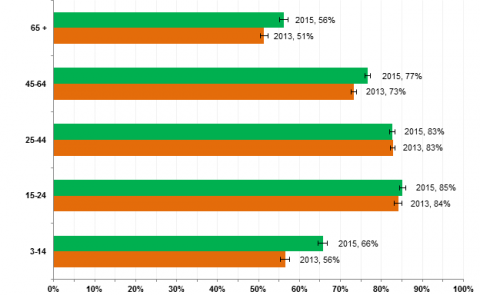Mar212016
Posted at 12:50 PM
Cross-blog post by John B. Morris, Jr., Associate Administrator, Office of Policy Analysis and Development, National Telecommunications and Information Administration (NTIA)
As the Obama Administration continues to focus on expanding broadband access and adoption, NTIA released new data today that shows that some of the demographic groups that have historically lagged behind in using the Internet—such as senior citizens, minorities, and Americans with lower levels of educational attainment—are making big strides.
Particularly promising, Internet use increased significantly among children and older Americans between 2013 and 2015. Children between the ages of 3 and 14 became substantially more likely to go online, as Internet use among this group increased from 56 percent in 2013 to 66 percent in 2015, and Internet use among those aged 65 or older increased from 51 percent to 56 percent during the same period. In contrast, usage remained largely unchanged among those who were previously most likely to go online, with 83 percent of Americans between the ages of 25 and 44 reporting Internet use in both 2013 and 2015.
The latest data comes from the Computer and Internet Use Supplement to the Current Population Survey (CPS), which included nearly 53,000 households and was conducted for NTIA by the U.S. Census Bureau in July 2015. The large sample size provides a detailed picture of where, why and how Americans go online.
During most of our first 20 years of computer and Internet use research, NTIA focused primarily on which households had Internet connections at home. We began asking households whether they had dial-up Internet connections at home in 1998, and added different types of broadband technologies starting in 2000. Today, only a small fraction of online households (about 400,000) rely on dial-up Internet connections. Our 2015 data shows that home Internet use among households, which includes both broadband and the small number of dial-up users, remained virtually flat in 2015 at 73 percent compared with 74 percent of households in 2013. Internet use has become much more of an individual activity in recent years, thanks to the spread of smartphones, mobile broadband, Wi-Fi, and a general proliferation of devices and connectivity. Accordingly, NTIA is now focusing primarily on Internet use among individual Americans from a range of locations—not just in their homes.
In this latest edition of our long-running series of surveys, we asked dozens of questions about who goes online, where they do so, what devices, technologies, and applications they use, and what barriers stand in the way of all Americans realizing the Internet’s full potential. We continued tracking long-running trends that shed light on Americans’ shifting usage habits and the digital divide. In addition, we gathered new data on a range of contemporary issues, from the use of wearables and connected household equipment to concerns about online privacy and security.
Over the coming months, our team at NTIA will continue analyzing this latest dataset and publishing our results here on the Digital Nation Blog. We also encourage researchers and the public at large to dive into the latest data. Our Data Explorer tool now includes metrics from 2015, and we will soon post the public use dataset and sample statistical code in the Research Center.
Please visit the latest blog on the NTIA Web site for more details on this dataset including charts outlining Internet use by age, educational attainment and racial and ethnic category.



